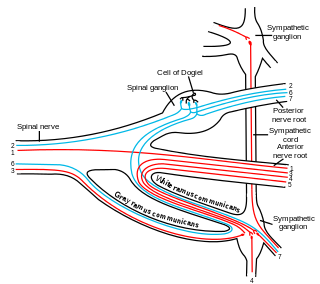 W
WThe sympathetic nervous system (SNS) is one of the two main divisions of the autonomic nervous system, the other being the parasympathetic nervous system.
 W
WThe adrenal medulla is part of the adrenal gland. It is located at the center of the gland, being surrounded by the adrenal cortex. It is the innermost part of the adrenal gland, consisting of cells that secrete epinephrine (adrenaline), norepinephrine (noradrenaline), and a small amount of dopamine in response to stimulation by sympathetic preganglionic neurons.
 W
WThe aorticorenal ganglion is composed of the superior mesenteric, renal, and inferior mesenteric ganglia. This is distinct from the celiac ganglia. However, they are part of the preaortic ganglia.
 W
WDogiel cells, also known as cells of Dogiel, refers to a type of multipolar neuronal cells within the prevertebral sympathetic ganglia. They are named after the Russian anatomist and physiologist Alexandre Dogiel (1852–1922). They play a role in the enteric nervous system.
 W
WThe fight-or-flight response is a physiological reaction that occurs in response to a perceived harmful event, attack, or threat to survival. It was first described by Walter Bradford Cannon. His theory states that animals react to threats with a general discharge of the sympathetic nervous system, preparing the animal for fighting or fleeing. More specifically, the adrenal medulla produces a hormonal cascade that results in the secretion of catecholamines, especially norepinephrine and epinephrine. The hormones estrogen, testosterone, and cortisol, as well as the neurotransmitters dopamine and serotonin, also affect how organisms react to stress. The hormone osteocalcin might also play a part.
 W
WThe hypogastric nerve is the nerve that transitions between the superior hypogastric plexus and the inferior hypogastric plexus. The hypogastric nerve enters the sympathetic chain at T10-L2.
 W
WThe inferior cardiac nerve arises from either the inferior cervical or the first thoracic ganglion.
 W
WThe inferior mesenteric ganglion is a ganglion located near where the inferior mesenteric artery branches from the abdominal aorta.
 W
WThe middle cardiac nerve, the largest of the three cardiac nerves, arises from the middle cervical ganglion, or from the trunk between the middle and inferior ganglia.
 W
WA paraganglion is a group of non-neuronal cells derived of the neural crest. They are named for being generally in close proximity to sympathetic ganglia. They are essentially of two types: (1) chromaffin or sympathetic paraganglia made of chromaffin cells and (2) nonchromaffin or parasympathetic ganglia made of glomus cells. They are neuroendocrine cells, the former with primary endocrine functions and the latter with primary chemoreceptor functions.
 W
WAlong the length of the sympathetic trunks are ganglia known as ganglia of sympathetic trunk, sympathetic ganglia or paravertebral ganglia. The ganglia are distinguished as cervical, thoracic, lumbar, and sacral and, except in the neck, they closely correspond in number to the vertebrae.
 W
WPrevertebral ganglia are sympathetic ganglia which lie between the paravertebral ganglia and the target organ.
 W
WThe ciliary ganglion is a parasympathetic ganglion located just behind the eye in the posterior orbit. Three types of axons enter the ciliary ganglion but only the preganglionic parasympathetic axons synapse there. The entering axons are arranged into three roots of the ciliary ganglion, which join enter the posterior surface of the ganglion.
 W
WThe branches of the ciliary ganglion are the short ciliary nerves.
 W
WStress, either physiological or biological, is an organism's response to a stressor such as an environmental condition. Stress is the body's method of reacting to a condition such as a threat, challenge or physical and psychological barrier. Stimuli that alter an organism's environment are responded to by multiple systems in the body. In humans and most mammals, the autonomic nervous system and hypothalamic-pituitary-adrenal (HPA) axis are the two major systems that respond to stress.
 W
WThe superior cardiac nerve arises by two or more branches from the superior cervical ganglion, and occasionally receives a filament from the trunk between the first and second cervical ganglia. It runs down the neck behind the common carotid artery, and in front of the Longus colli muscle; and crosses in front of the inferior thyroid artery, and recurrent nerve. The course of the nerves on the two sides then differs.
 W
WIn the upper part of the superior mesenteric plexus close to the origin of the superior mesenteric artery is a ganglion, the superior mesenteric ganglion.
 W
WThe sympathetic ganglia, or autonomic ganglia, are the ganglia of the sympathetic nervous system. Ganglia are 20,000 to 30,000 afferent and efferent nerve cell bodies that run along on either side of the spinal cord. Afferent nerve cell bodies bring information from the body to the brain and spinal cord, while efferent nerve cell bodies bring information from the brain and spinal cord to the rest of the body. The cell bodies create long sympathetic chains that are on either side of the spinal cord. They also form para- or pre-vertebral gangalia of gross anatomy.
 W
WThe sympathetic trunks are a paired bundle of nerve fibers that run from the base of the skull to the coccyx. They are a major component of the sympathetic nervous system.
 W
WSympathicolysis is a procedure for temporary or long-term elimination of sympathetic innervation. It is used to improve blood circulation in the legs or arms. The sympathetic nervous system causes the balance of the autonomic system to lean towards narrowing of blood vessels, with elimination of its function resulting in vasodilatation. Completely blocked arteries are not opened again, but the collaterals are better supplied with blood.
 W
WThoracic splanchnic nerves are splanchnic nerves that arise from the sympathetic trunk in the thorax and travel inferiorly to provide sympathetic innervation to the abdomen. The nerves contain preganglionic sympathetic fibers and general visceral afferent fibers.